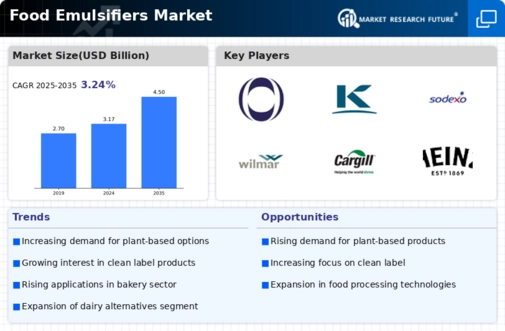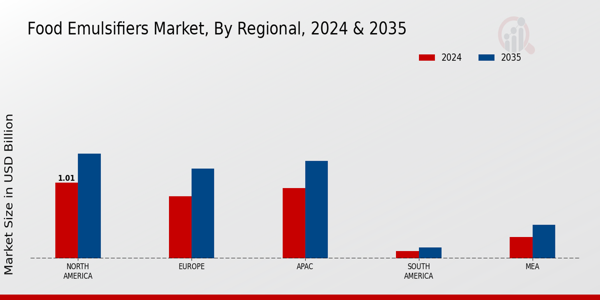Food Emulsifiers Size
Food Emulsifiers Market Growth Projections and Opportunities
Several market factors significantly influence the Food Emulsifiers market, shaping its dynamics and growth trajectory. One key factor is the rising demand for convenience foods and processed products. As consumer lifestyles become busier, there is an increased preference for ready-to-eat and easy-to-prepare food items. Food emulsifiers play a crucial role in enhancing the texture, stability, and shelf life of these processed foods, driving their adoption in various food applications.
Health and wellness trends are another influential factor in the Food Emulsifiers market. Consumers are increasingly conscious of their dietary choices, seeking healthier and cleaner-label products. In response, manufacturers are incorporating natural and plant-based emulsifiers, addressing concerns about synthetic additives. The demand for emulsifiers that align with clean-label and organic trends reflects the broader shift towards more transparent and health-oriented food formulations.
Globalization and changing dietary habits contribute to the growth of the Food Emulsifiers market. As people embrace diverse cuisines and international food trends, the demand for processed and packaged foods rises. Food emulsifiers are integral to the production of a wide range of food products, including baked goods, confectionery, and dairy items, supporting the globalization of food choices and catering to evolving taste preferences.
The expansion of the food industry, particularly in emerging markets, is a significant factor driving the Food Emulsifiers market. As economies grow and consumer purchasing power increases, there is a parallel rise in the demand for processed and packaged foods. This, in turn, fuels the need for food emulsifiers to enhance product quality, appearance, and texture. The food industry's expansion into new regions creates opportunities for emulsifier manufacturers to establish a presence and meet the growing demand.
Regulatory factors play a crucial role in shaping the Food Emulsifiers market. Stringent regulations regarding food safety and ingredient labeling influence the formulation and use of emulsifiers. Manufacturers need to comply with regulatory standards and obtain certifications to ensure the safety and quality of their products. Regulatory scrutiny also drives innovation, pushing companies to develop emulsifiers that meet evolving standards and cater to changing consumer preferences.
Technological advancements and research in the field of food science contribute to the growth of the Food Emulsifiers market. Ongoing research leads to the development of new emulsification technologies and the discovery of novel ingredients. This enables manufacturers to create emulsifiers with improved functionalities, stability, and compatibility with various food formulations, meeting the dynamic needs of the food industry.
Competitive factors also shape the Food Emulsifiers market landscape. With numerous players operating in the market, competition is intense. Companies strive to differentiate themselves through product innovation, branding, and strategic partnerships. Market leaders invest in research and development to stay ahead in terms of technology and product offerings, while smaller players often focus on niche applications or specialty emulsifiers to carve out their market share.
Environmental and sustainability considerations are increasingly influencing the Food Emulsifiers market. As consumers and manufacturers become more environmentally conscious, there is a growing demand for sustainable and ethically sourced ingredients, including emulsifiers. Companies that adopt eco-friendly production practices and emphasize sustainability in their sourcing and manufacturing processes gain a competitive edge in an evolving market landscape.














Leave a Comment